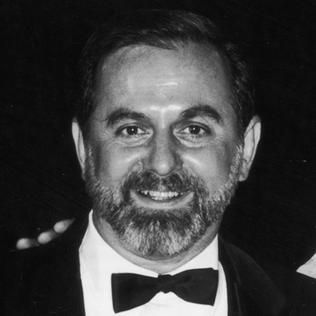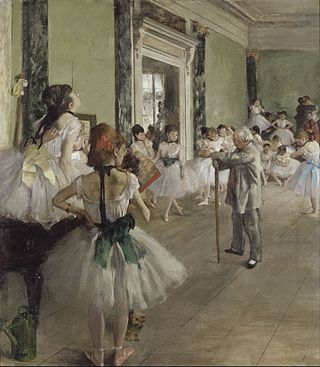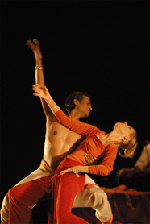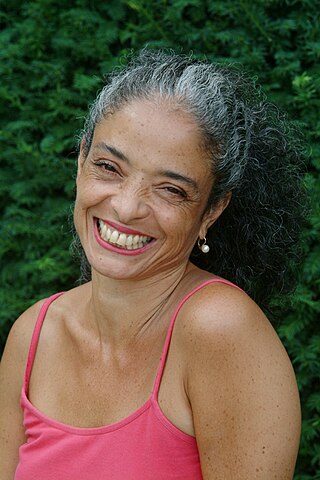Related Research Articles

August Bournonville was a Danish ballet master and choreographer. He was the son of Antoine Bournonville, a dancer and choreographer trained under the French choreographer, Jean Georges Noverre, and the nephew of Julie Alix de la Fay, née Bournonville, of the Royal Swedish Ballet.

Marie Taglioni, Comtesse de Voisins was a Swedish-born ballet dancer of the Romantic ballet era partially of Italian descent, a central figure in the history of European dance. She spent most of her life in the Austrian Empire and France. She was one of the most celebrated ballerinas of the romantic ballet, which was cultivated primarily at Her Majesty's Theatre in London and at the Théâtre de l'Académie Royale de Musique of the Paris Opera Ballet. She is credited with being the first ballerina to truly dance en pointe.

The Paris Opera Ballet is a French ballet company that is an integral part of the Paris Opera. It is the oldest national ballet company, and many European and international ballet companies can trace their origins to it. It is still regarded as one of the four most prominent ballet companies in the world, together with the Bolshoi Ballet in Moscow, the Mariinsky Ballet in Saint Petersburg and the Royal Ballet in London.

Mark William Morris is an American dancer, choreographer and director whose work is acclaimed for its craftsmanship, ingenuity, humor, and at times eclectic musical accompaniments. Morris is popular among dance aficionados, the music world, as well as mainstream audiences.

Robert Joffrey was an American dancer, teacher, producer, choreographer, and co-founder of the Joffrey Ballet, known for his highly imaginative modern ballets. He was born Anver Bey Abdullah Jaffa Khan in Seattle, Washington to a Pashtun father from Afghanistan and a mother from Italy.

A ballet master is an employee of a ballet company who is responsible for the level of competence of the dancers in their company. In modern times, ballet masters are generally charged with teaching the daily company ballet class and rehearsing the dancers for both new and established ballets in the company's repertoire. The artistic director of a ballet company, whether a male or female, may also be called its ballet master. Historic use of gender marking in job titles in ballet is being supplanted by gender-neutral language job titles regardless of an employee's gender.

Roland Petit was a French ballet company director, choreographer and dancer. He trained at the Paris Opera Ballet school, and became well known for his creative ballets.

Ballet is a formalized form of dance with its origins in the Italian Renaissance courts of 15th and 16th centuries. Ballet spread from Italy to France with the help of Catherine de' Medici, where ballet developed even further under her aristocratic influence. An early example of Catherine's development of ballet is through 'Le Paradis d' Amour', a piece of work presented at the wedding of her daughter Marguerite de Valois to Henry of Navarre. Aristocratic money was responsible for the initial stages of development in 'court ballet', as it was royal money that dictated the ideas, literature and music used in ballets that were created to primarily entertain the aristocrats of the time. The first formal 'court ballet' ever recognized was staged in 1573, 'Ballet des Polonais'. In true form of royal entertainment, 'Ballet des Polonais' was commissioned by Catherine de' Medici to honor the Polish ambassadors who were visiting Paris upon the accession of Henry of Anjou to the throne of Poland. In 1581, Catherine de' Medici commissioned another court ballet, Ballet Comique de la Reine, however it was her compatriot, Balthasar de Beaujoyeulx, who organized the ballet. Catherine de' Medici and Balthasar de Beaujoyeulx were responsible for presenting the first court ballet ever to apply the principles of Baif's Academie, by integrating poetry, dance, music and set design to convey a unified dramatic storyline. Moreover, the early organization and development of 'court ballet' was funded by, influenced by and produced by the aristocrats of the time, fulfilling both their personal entertainment and political propaganda needs.

Benjamin Millepied is a French dancer and choreographer, who has lived and worked in the United States since joining the New York City Ballet in 1995, where he became a soloist in 1998 and a principal in 2002. He has also created choreography for the company, and choreographed pieces for other major companies. He retired from the NYCB in 2011.

Carolyn Carlson is an American born French nationalized contemporary dance choreographer, performer, and poet. She is of Finnish descent.

Daniela Malusardi is an Italian choreographer, teacher and dancer.

The Polish National Ballet is the largest and most influential ballet company in Poland. It continues a ballet heritage, dating to the 17th century.
Henning Rübsam is a choreographer and dancer based in New York City. He is the artistic director of SENSEDANCE, a faculty member of The Juilliard School and Fordham University, and a visiting guest professor at Texas Academy of Ballet. He is the dance curator for Arts at Work and a resident choreographer for Hartford City Ballet.
Vincenzo Celli was an American ballet dancer, choreographer, and teacher. He was known as a performer and choreographer in Italy, and in the US as a teacher of the Cecchetti method of ballet training.
Enzo Celli is an Italian contemporary dancer, choreographer and dance company artistic director

Rosina Galli was an Italian ballet dancer, choreographer, ballet mistress, and dance teacher. After early years in Italy, she moved to the US, where she was associated with the Metropolitan Opera in New York City. Prima ballerina at La Scala Theatre Ballet, and the Chicago Ballet, she was also the première danseuse at the Teatro di San Carlo and the Metropolitan Opera.

The important place of women in dance can be traced back to the origins of civilization. Cave paintings, Egyptian frescos, Indian statuettes, ancient Greek and Roman art and records of court traditions in China and Japan all testify to the important role women played in ritual and religious dancing from the start. In the Middle Ages, what has become known as ballet had its beginnings in Italian court festivals when women frequently played the parts of men. It was however in late 17th-century France that the Paris Opera produced the first celebrated ballerinas. While women began to dominate the ballet scene in the 18th century, it was with the advent of Romantic ballet in the 19th century that they became the undisputed centre of attraction with stars playing the leading roles in the works of Marius Petipa, appearing in theatres across Europe from Milan's La Scala to the Mariinsky Theatre in Saint Petersburg. More recently, women have played a leading role in developing various forms of modern dance including flamenco and expressionist dance.

Blakeley White-McGuire born in Baton Rouge, Louisiana, is a dancer, choreographer, répétiteur, and educator. She is a Principal Guest Artist and former Principal Dancer of Martha Graham Dance Company. Described by Gia Kourlas of the New York Times as having a "powerful technique and dramatic instinct with an appealing modern spunk", White-McGuire has received widespread critical acclaim as a Graham dancer.
Gisella Caccialanza was an American prima ballerina and teacher who danced in theater, opera and film productions. She studied ballet under Italian teacher Giovanni Rosi, and then with ballet dancer Enrico Cecchetti at La Scala in Milan, Italy. Caccialanza danced with Viennese choreographer Albertina Rasch, the School of American Ballet, the New Opera Company, and the San Francisco Ballet, with which she later taught and coached.
References
- La Rocco, Claudia (1 August 2008). "For Luca Veggetti, a fresh dance of independence", The New York Times . Retrieved 2009-10-21.